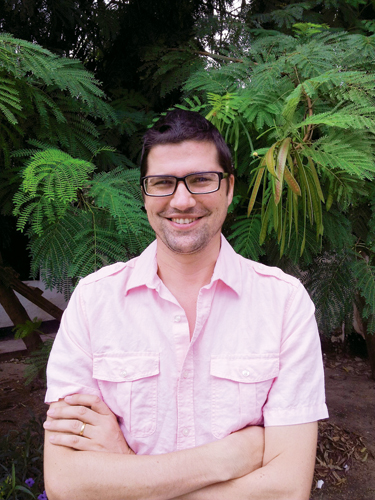Theron Morgan-Brown BA ’00
Open gallery

As the Lewis & Clark overseas study program celebrates its 50th year, six alumni reflect on their life-changing journeys. Learn more about Theron Morgan-Brown BA ’00 below and then browse other alumni stories.
From: Bandon, Oregon
Overseas Program: East Africa, 1998
Currently: Technical Advisor for the Tanzania Community Forest Conservation Network, Dar es Salaam, Tanzania
The “butterfly effect” of chaos theory posits that an event as seemingly insignificant as the fluttering of a butterfly’s wings can change the course of the world. Theron Morgan-Brown has seen the theory play out in the most literal sense, as the choices he made at Lewis & Clark continue to reverberate in the East Usambara Mountains of Tanzania. There, the fluttering of butterfly wings is helping to lift six villages out of poverty while preserving a rich swath of biodiverse rainforest.
Theron is the founder of the Amani Butterfly Project, a development project that fluttered to life as the eventual result of his semester overseas on Lewis & Clark’s East Africa program. In his first two weeks in Tanzania, says Theron, “I was so overwhelmed by the extreme poverty of the country that I developed shingles.” Soon, however, he became captivated by the culture, and by a desire to help. “Now,” says Theron, “I live here. Many things that are uncomfortable are still worth doing.”
Returning to Oregon, the art and biology double major changed directions and began to pursue economic development. In his last year at Lewis & Clark, Theron got involved in a captive rearing program for the threatened Oregon silverspot butterfly, a program started by Paulette Bierzychudek, Swindells Professor of Natural Sciences. It reminded him of a butterfly farming project he had heard about in Kenya, and it got him wondering: would butterfly farming be feasible in Tanzania? After graduating, he returned as a Fulbright Scholar to find out.
The overseas program altered the direction of my life, and I’m truly happy with the outcome.
After six months of Fulbright research in the Usambara Mountains, Theron realized, “Not only was the project feasible, but I wanted to start it.” Today, the thriving nonprofit helps rural Tanzanians supplement their income by propagating native butterflies and selling the pupae to aviaries in the United States and Europe. Participating families have seen their incomes rise by an average of 25 percent—a huge difference in an area where the average household brings in less than $400 per month. In a follow-up study for his master’s thesis, Theron found that a second goal had been realized: the added income has created a substantial economic incentive to conserve the neighboring forest, which is needed both to maintain genetic diversity in the captive butterfly populations and to supply native host plants for the pupae.
Today, Theron continues to advise on the project and works with a forest conservation group in Dar es Salaam, where he lives with his Tanzanian wife, Jacqueline, and their son, Kweli. “The overseas program altered the direction of my life,” he says, “and I’m truly happy with the outcome.”
Read about how other alumni were influenced by their overseas experiences:
Amy Lillis BA ’04
Overseas Program: India, 2001
Cynthia Owens BS ’80
Overseas Program: Israel, 1980
Jodi Eichelberger BA ’93
Overseas Program: London, 1992
Paul Jorgensen BA ’85
Overseas Program: Denmark/Greenland, 1983
Ross Mouer BA ’66
Overseas Program: Japan, 1962
Read “Around the World in 50 Years,” from the Spring 2012 issue of the Chronicle magazine.
More L&C Magazine Stories
Lewis & Clark Magazine is located in McAfee on the Undergraduate Campus.
MSC: 19
email magazine@lclark.edu
voice 503-768-7970
fax 503-768-7969
The L&C Magazine staff welcomes letters and emails from readers about topics covered in the magazine. Correspondence must include your name and location and may be edited.
Lewis & Clark Magazine
Lewis & Clark
615 S. Palatine Hill Road MSC 19
Portland OR 97219

